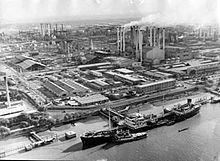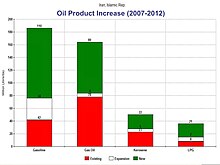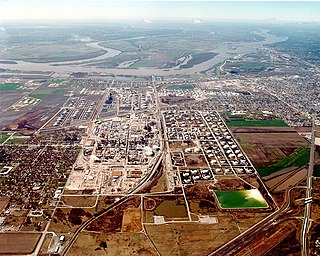
National Iranian Oil Refining and Distribution Company (NIORDC) is part of the Ministry of Petroleum of Iran. NIORDC was established on 8 March 1991 and undertook to perform all operations relating to refining and distribution of oil products.

National Iranian Oil Refining and Distribution Company (NIORDC) is part of the Ministry of Petroleum of Iran. NIORDC was established on 8 March 1991 and undertook to perform all operations relating to refining and distribution of oil products.


As of 2010, NIORDC had 19 subsidiaries and affiliated companies, including 9 oil existing refineries. [1] Between 2007 and 2012, oil refining capacity for crude oil and gas condensate would increase from 1,600,000 barrels per day (250,000 m3/d) to 3,300,000 barrels per day (520,000 m3/d). [2] By 2009, Iran had a total refining capacity of 1,860,000 barrels per day (296,000 m3/d). [3]
| Refinery | Installed Capacity (bbl/d) |
|---|---|
| Abadan | 350,000 |
| Isfahan | 280,000 |
| Arak (Imam-Khomeini) | 250,000 |
| Bandar Abbas | 230,000 |
| Tehran (Shahid Tondgouyan) | 220,000 (Euro 5 compliant by 2012)[ citation needed ] |
| Arvand Oil Refinery | 120,000 |
| Lavan Island | 63,000 (Since 2012) |
| Tabriz | 100 |
| Kermanshah | 40 |
| Shiraz | 30 |
| Total: | 1.45 Mbbl/d (231,000 m3/d). |
| Oil Products | KBPD (thousand barrel per day) | Percent |
|---|---|---|
| Gasoline | 283 | 17% |
| Gas oil | 511 | 32% |
| Kerosene (Jet fuel) | 136 | 8% |
| Fuel oil | 457 | 29% |
| LPG | 50 | 3% |
| Others | 184 | 11% |
Other facilities:
Major gasoline suppliers to Iran historically have been India, Turkmenistan, Azerbaijan, the Netherlands, France, Singapore, and the United Arab Emirates. [6] [7] The Financial Times reported that Vitol, Glencore, Trafigura and other (western) companies had since stopped supplying petrol to Iran because of international sanctions. [8] In 2006, Vitol, a MNC based in Switzerland, supplied Iran with 60% of its total gasoline cargo imports. [6]

| 2008 | 2009 |
|---|---|
| BP (UK) | CNPC (China) |
| ENOC (UAE) | Glencore (Switzerland) |
| Glencore (Switzerland) | IPG (Kuwait) |
| IPG (Kuwait) | Litasco (Russia) |
| MEP (UAE) | Petronas (Malaysia) |
| Reliance Industries (India) | Reliance Industries (India) |
| Shell (Netherlands) | Shell (Netherlands) |
| SPC (Singapore) | Total (France) |
| Total (France) | Trafigura (Switzerland) |
| Trafigura (Switzerland) | Vitol (Switzerland) |
| Vitol (Switzerland) | Zhenhua Oil (China) |
While the country remains dependent on small gasoline and diesel imports, net gasoline imports in 2013 averaged only 33 000 bpd. This compares to refined product imports of 182 000 bpd in 2009, of which two thirds was gasoline (approximately 132 000 bpd). [17]
| Refinery | Location | Refining capacity [18] | Estimated costs [19] | Estimated completion date [19] |
|---|---|---|---|---|
| Khuzestan refinery (privately owned) | Arvand Free Zone, near Abadan | 180,000 barrels per day (29,000 m3/d). The refinery will refine the heavy crude oil produced in Azadegan and Yadavaran oil fields. It will also produce 10 million litres (2,600,000 US gallons; 2,200,000 imperial gallons) of super gasoline complying with Euro IV standard, 12.6 million litres (3,300,000 US gal; 2,800,000 imp gal) of diesel oil, 3 million litres (790,000 US gal; 660,000 imp gal) of jet fuel, 5 million litres (1,300,000 US gal; 1,100,000 imp gal) of liquefied gas, and 440 tonnes (430 long tons; 490 short tons) of sulfur. | 2.9 billion euros | 2012 |
| The Persian Gulf Star refinery | Assalouyeh | 360,000 of gas condensates per day and to produce gasoline, jet fuel, and other valuable products. | 2.5 billion euros | 2010 |
| Shahriar refinery | Tabriz | 150,000 barrels per day (24,000 m3/d); gasoline production: 70,000 barrels per day (11,000 m3/d) | 1.2 billion euros | 2012 |
| Anahita refinery | Kermanshah Province | 150,000 barrels per day (24,000 m3/d) | 1.3 billion euros | 2012 |
| Hormoz refinery | Bandar Abbas | 300,000 barrels (48,000 m3) of heavy and extra heavy crude oil | $4.3 billion | 2012 |
| Caspian refinery | Gorgan, Golestan Province | 300,000 barrels (48,000 m3) of crude oil; 20 million litres (5,300,000 US gal; 4,400,000 imp gal) of gasoline, 11 million litres (2,900,000 US gal; 2,400,000 imp gal) of gas oil from Caspian Sea countries with exports to Turkey, Afghanistan and Pakistan | $4 billion | 2013 |
| Pars refinery | Shiraz | 120,000 barrels per day (19,000 m3/d) | 800 million euros | 2012 |
| Refinery | Location | Refining capacity | Estimated costs | Completion date |
|---|---|---|---|---|
| Yasouj refinery | Yasouj | 150,000 barrels per day (24,000 m3/d). The refinery will produce petrol, gasoil, kerosene, furnace oil, liquefied gas, asphalt, and sulfur. [21] | $2.2 billion | 2014 |
Planned in 2011, Qeshm refinery (capable of processing heavy crude oil) will have an output capacity of 30,000 barrels a day of light oil products and will become operational by 2014. [22]
The NIORDC subsidiaries are as follows:

The Strategic Petroleum Reserve (SPR) is an emergency stockpile of petroleum maintained by the United States Department of Energy (DOE). It is the largest publicly known emergency supply in the world; its underground tanks in Louisiana and Texas have capacity for 714 million barrels (113,500,000 m3). The United States started the petroleum reserve in 1975 to mitigate future supply disruptions as part of the international Agreement on an International Energy Program, after oil supplies were interrupted during the 1973–1974 oil embargo.

A barrel is one of several units of volume applied in various contexts; there are dry barrels, fluid barrels, oil barrels, and so forth. For historical reasons the volumes of some barrel units are roughly double the volumes of others; volumes in common use range approximately from 100 to 200 litres. In many connections the term drum is used almost interchangeably with barrel.
Petroleum production in Canada is a major industry which is important to the overall economy of North America. Canada has the third largest oil reserves in the world and is the world's fourth largest oil producer and fourth largest oil exporter. In 2019 it produced an average of 750,000 cubic metres per day (4.7 Mbbl/d) of crude oil and equivalent. Of that amount, 64% was upgraded from unconventional oil sands, and the remainder light crude oil, heavy crude oil and natural-gas condensate. Most of the Canadian petroleum production is exported, approximately 600,000 cubic metres per day (3.8 Mbbl/d) in 2019, with 98% of the exports going to the United States. Canada is by far the largest single source of oil imports to the United States, providing 43% of US crude oil imports in 2015.

Kochi Refinery Limited (KRL) is a crude oil refinery in the city of Kochi in Kerala, India. It is the largest public sector refinery in India with a production capacity of 15.5 million tonnes per year. Formerly known as Cochin Refineries Limited and later renamed as Kochi Refineries Limited, it was acquired by Bharat Petroleum Corporation Limited in the year 2006. The refinery is situated at Ambalamugal, around 12 km (7.5 mi) east of the city centre.
Global strategic petroleum reserves (GSPR) refer to crude oil inventories held by the government of a particular country, as well as private industry, to safeguard the economy and help maintain national security during an energy crisis. Strategic reserves are intended to be used to cover short-term supply disruptions.

The Wood River Refinery is an oil refinery located in Roxana, Illinois, approximately 15 miles (24 km) north of St. Louis, Missouri, on the east side of the Mississippi River. The refinery is currently owned by Phillips 66 and Cenovus Energy and operated by the joint-venture company WRB Refining, LLC (WRB). WRB was formed on 1 July 2007, with Encana taking a 49% interest in Wood River and also Phillips 66's Borger refinery. Encana subsequently spun off oil sands producer Cenovus and ConocoPhillips spun off Phillips 66. In return for a 49% stake in the refinery, ConocoPhillips gained a joint interest in two Alberta oil sands (bitumen) heavy oil projects: Christina Lake (Alberta) and Foster Creek. ConocoPhillips’ interest was sold to Cenovus in May 2017, leaving Cenovus as the sole owner of the assets.

The Ministry of Petroleum (MOP) (Persian: وزارت نفت, romanized: Vezârat-e Naft) manages the oil industry, the producer of oil and petrochemical products. MoP is in charge of all issues pertaining to exploration, extraction, exploitation, distribution and exportation of crude oil and oil products. In addition, according to the "Imports and Exports Regulation Act", issuing import licenses for such products is also among the functions of the Ministry of Petroleum. The ministry has been placed under sanctions by the United States Department of State as of 2020.

The usage and pricing of gasoline results from factors such as crude oil prices, processing and distribution costs, local demand, the strength of local currencies, local taxation, and the availability of local sources of gasoline (supply). Since fuels are traded worldwide, the trade prices are similar. The price paid by consumers largely reflects national pricing policy. Most countries impose taxes on gasoline (petrol), which causes air pollution and climate change; whereas a few, such as Venezuela, subsidize the cost. Some country's taxes do not cover all the negative externalities, that is they do not make the polluter pay the full cost. Western countries have among the highest usage rates per person. The largest consumer is the United States.

U.S. Oil & Refining Co. is an oil refinery located in the tideflats of Tacoma, Washington.
The 2007 gasoline rationing plan in Iran was launched by president Mahmoud Ahmadinejad's cabinet to reduce that country's fuel consumption. Although Iran is one of the world's largest producers of petroleum, rapid increases in demand and limited refining capacity have forced the country to import about 40% of its gasoline, at an annual cost of up to USD $7 billion.

Gdańsk oil refinery is a 10.5 million tonne per year refinery located near the Polish city of Gdańsk on the Baltic Sea. The refinery was established in 1975 to supply fuels and lubricants, and has undergone several upgrades and expansions to increase its capacity and the range of products available. It now has a Nelson complexity index of 11.1. It is one of two oil refineries in Poland, the other is Plock refinery.
The Aspropyrgos Refinery is an oil refining complex located near Aspropyrgos, a suburb of Athens, in Greece. It is operated by Hellenic Petroleum. The refinery has a nominal annual refining capacity of 7.5 million tons.
Western Refining, Inc., is a Texas-based Fortune 200 and Global 2000 crude oil refiner and marketer operating primarily in the Southwestern, North-Central and Mid-Atlantic regions of the United States. Western Refining (WNR) has been publicly traded on the New York Stock Exchange since January 2006 and is the fourth largest publicly traded independent refiner and marketer in the nation.

Petroleum has been a major industry in the United States since the 1859 Pennsylvania oil rush around Titusville, Pennsylvania. Commonly characterized as "Big Oil", the industry includes exploration, production, refining, transportation, and marketing of oil and natural gas products. The leading crude oil-producing areas in the United States in 2023 were Texas, followed by the offshore federal zone of the Gulf of Mexico, North Dakota and New Mexico.

The Chevron Richmond Refinery is a 2,900-acre (1,200 ha) petroleum refinery in Richmond, California, on San Francisco Bay. It is owned and operated by Chevron Corporation and employs more than 1,200 workers, making it the city's largest employer. The refinery processes approximately 240,000 barrels (38,000 m3) of crude oil a day in the manufacture of petroleum products and other chemicals. The refinery's primary products are motor gasoline, jet fuel, diesel fuel and lubricants.
The Co-op Refinery Complex (CRC), formerly known as Consumers’ Co-operative Refineries Limited (CCRL), is an oil refinery spread over 544 acres (2.20 km2) located in the city of Regina, Saskatchewan, Canada, owned and operated [source needed] by Consumers Co-operative Refinery Limited, an affiliate of Federated Co-operatives Limited (FCL). The refinery provides oil products to the member co-operatives of Federated Co-operatives Limited as well as most other petroleum retailers in the region including major national and regional brands. The complex completed a CA$2.9 billion upgrade project in 2012 to increase operations up to 145,000 barrels per day (23,100 m3/d)

Iran is an energy superpower and the petroleum industry in Iran plays an important part in it. In 2004, Iran produced 5.1 percent of the world's total crude oil, which generated revenues of US$25 billion to US$30 billion and was the country's primary source of foreign currency. At 2006 levels of production, oil proceeds represented about 18.7% of gross domestic product (GDP). However, the importance of the hydrocarbon sector to Iran's economy has been far greater. The oil and gas industry has been the engine of economic growth, directly affecting public development projects, the government's annual budget, and most foreign exchange sources.

The Tema Oil Refinery (TOR) is one of two crude oil refineries in Ghana. In 1977, the Government of Ghana became the sole shareholder. The name of the refinery was changed to the Tema Oil Refinery in 1991. The refinery was first named the Ghanaian Italian Petroleum Company (GHAIP).

Petroleum refining in the United States in 2013 produced 18.9 million barrels per day of refined petroleum products, more than any other country. Although the US was the world's largest net importer of refined petroleum products as recently as 2008, the US became a net exporter in 2010, and in 2014 was the largest exporter and the largest net exporter of refined petroleum. As of January 2019, there were 135 operating refineries in the US, distributed among 30 states.